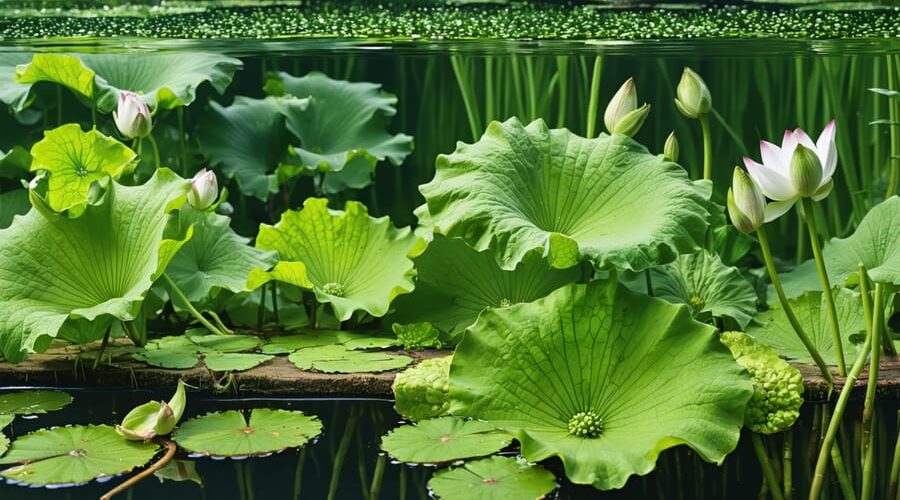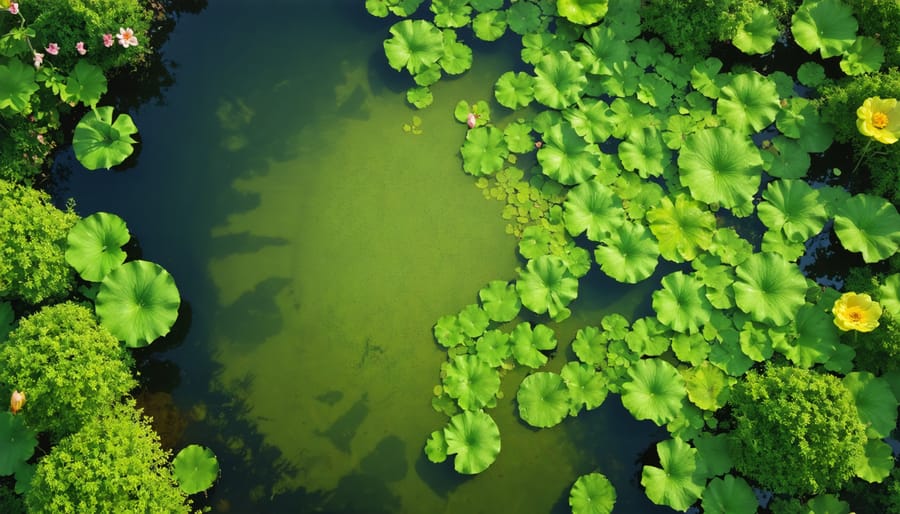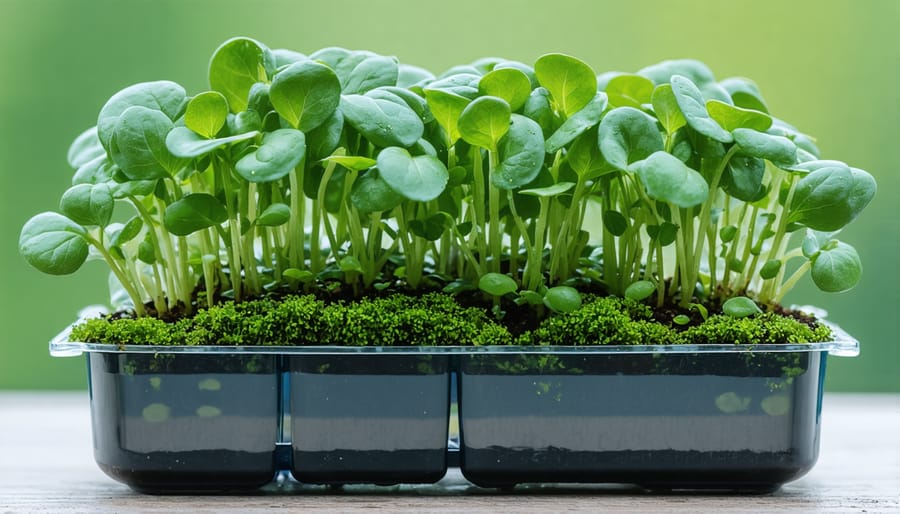
Transform Your Pond into an Edible Paradise: Smart Ways to Grow Aquatic Food Plants
Discover the hidden potential of your backyard pond by cultivating edible pond plants that transform your water feature into a thriving food garden. Water chestnuts, watercress, and lotus roots offer both stunning aquatic displays and nutritious harvests throughout the growing season. These aquatic edibles require minimal maintenance while naturally filtering your pond water and creating essential habitats for beneficial wildlife.
From the protein-rich seeds of water lotus to the vitamin-packed leaves of watercress, underwater edibles provide year-round sustainability right in your backyard. Native species like wild rice and arrowhead flourish in various water depths, making them perfect additions for both shallow margins and deeper zones. Better yet, these hardy plants naturally resist common pond problems like algae growth by competing for nutrients that would otherwise feed unwanted growth.
Whether you’re an experienced water gardener or just starting your aquatic journey, growing edible underwater plants offers a unique blend of ornamental beauty and practical food production. Their dual-purpose nature makes them an ideal choice for sustainable landscaping, while their easy-care requirements ensure success for gardeners at any skill level.
Popular Edible Pond Plants for Your Water Garden

Water Chestnuts and Lotus
Water chestnuts and lotus are two of the most rewarding edible aquatics you can grow in your water garden. Water chestnuts thrive in shallow, muddy conditions and produce crispy, sweet corms that add a delightful crunch to stir-fries and salads. Plant them in spring, spacing them about 6 inches apart in containers filled with heavy garden soil, and submerge them in 2-4 inches of water.
Lotus plants are stunning additions that serve double duty – their beautiful flowers attract pollinators while their edible tubers, young leaves, and seed pods provide nutritious harvest options. They need deeper water than water chestnuts, preferring depths of 6-24 inches. Plant lotus tubers in large containers using heavy clay soil, and don’t be discouraged if growth seems slow at first – they’ll spread vigorously once established.
Both plants prefer full sun and nutrient-rich soil. Harvest water chestnuts in fall when the leaves start yellowing, and gather lotus tubers in late fall or early spring. Remember to leave some roots behind for next season’s growth. These aquatic edibles are relatively low-maintenance once established and can provide years of harvests with proper care.
Watercress and Water Spinach
Watercress and water spinach are two of the most popular and versatile aquatic leafy greens you can grow in your water garden. Watercress, with its crisp texture and peppery flavor, thrives in moving water and can be grown in shallow streams or container water gardens. It’s incredibly nutritious, packed with vitamins A, C, and K, making it a fantastic addition to salads and sandwiches.
Water spinach, also known as morning glory or kangkong, is a fast-growing tropical plant that flourishes in warm, still water. Its tender shoots and leaves are commonly used in Asian cuisine, particularly in stir-fries and soups. The plant spreads quickly, so it’s best grown in contained areas where you can manage its growth.
Both plants are easy to start from cuttings or seeds and can be harvested throughout the growing season. For watercress, simply snip the stems above the water line, and they’ll regrow for multiple harvests. Water spinach can be harvested by cutting the stems about 6 inches above the water, encouraging new growth for continuous harvesting.
Remember to grow these plants in clean, fresh water and wash them thoroughly before eating. In colder climates, consider moving them indoors during winter to extend their growing season.
Wild Rice and Other Aquatic Grains
Wild rice, a treasured aquatic grain, thrives in slow-moving waters and can be a wonderful addition to your water garden. Unlike conventional rice, wild rice grows naturally in North American waters and requires minimal maintenance once established. To grow wild rice, you’ll need water depths between 6 inches and 3 feet, with slightly acidic conditions.
Start by scattering seeds in spring when water temperatures reach about 50°F (10°C). The seeds will naturally sink and establish themselves in the muddy bottom. Wild rice plants typically take about 120 days to mature, producing elegant stalks that can reach heights of 8 feet or more.
Other aquatic grains worth considering include water bamboo and water chestnuts. Water bamboo prefers shallow waters and rich, muddy soil, while water chestnuts grow best in sunny locations with 3-6 inches of water. Both plants not only provide edible portions but also add visual interest to your pond.
For successful cultivation, maintain consistent water levels and protect young plants from waterfowl, which find these grains particularly tasty. Harvest wild rice when the seeds turn dark brown and begin to drop naturally. For water chestnuts, harvest the corms in late fall when the leaves start yellowing.
Setting Up Your Edible Pond Garden
Planting Zones and Depth Requirements
When planning your edible underwater garden, proper plant placement is crucial for creating a sustainable pond ecosystem. Most edible aquatic plants thrive in specific zones, each with its own depth requirements.
Shallow marginal zones (0-6 inches deep) are perfect for watercress, water mint, and taro. These plants prefer their roots submerged while their leaves remain above water. Plant them in containers filled with heavy garden soil, topped with gravel to prevent soil dispersal.
Mid-depth zones (6-12 inches) accommodate plants like water chestnuts and lotus. These plants need deeper water for their root systems but still require their leaves to reach the surface. Use large, sturdy containers and rich, clay-based soil for best results.
Deep-water zones (12-24 inches) are ideal for wild rice and certain varieties of water lily with edible parts. These plants have extensive root systems and need plenty of space to grow. Secure them in deep baskets with adequate soil and anchoring stones.
Remember to consider your local climate when choosing planting depths. In colder regions, you might need to place plants slightly deeper to protect them from winter freeze, while in warmer areas, shallower placement can help prevent overheating during summer months.
Soil and Container Options
When growing edible underwater plants, choosing the right growing medium and container is crucial for success. For submerged plants, a mixture of heavy garden soil and clay works best, providing essential nutrients and stability. Avoid using regular potting soil, as it tends to float and cloud the water.
For container options, mesh baskets lined with burlap or coconut fiber work excellently, allowing roots to spread while keeping the soil in place. Fabric grow bags are another fantastic choice, especially for larger plants like water chestnuts. If you’re planning an integrated aquaculture system, consider using weighted planting pots that can be easily moved around your pond.
The depth of your containers matters too. Most edible underwater plants thrive in containers 6-12 inches deep, though some might need more space for their root systems. When filling containers, leave about an inch at the top for a layer of gravel or small stones. This prevents soil from floating away and gives your plants extra stability.
Remember to start with clean containers and sterile growing medium to prevent introducing unwanted organisms into your water garden. For beginners, pre-made aquatic planting baskets are a great starting point, offering the right combination of drainage and stability for your underwater edibles.

Maintaining Your Edible Aquatic Garden
Seasonal Care and Pruning
Caring for edible underwater plants requires attention throughout the growing season to ensure a bountiful harvest. During spring, remove any dead or yellowing leaves to encourage new growth. As summer progresses, thin out dense vegetation to prevent overcrowding and maintain good water circulation.
Most aquatic edibles benefit from monthly fertilization during the growing season. Use specialized aquatic plant tablets, pushing them into the soil near the plant roots. Be careful not to over-fertilize, as this can lead to algae problems in your pond.
Pruning is essential for maintaining healthy plants and preventing them from taking over your water garden. Harvest leaves and stems regularly, which encourages bushier growth and provides fresh ingredients for your kitchen. For floating plants like water chestnuts, remove any damaged leaves that could decay and affect water quality.
In late summer, reduce fertilization to prepare plants for dormancy. Before winter, cut back plants to about 2-3 inches above the water line. Some species, like watercress and water mint, can be divided in spring or fall to create new plants and control their spread.
Remember to monitor water levels throughout the season, especially during hot weather when evaporation increases. Top up as needed with dechlorinated water to maintain optimal growing conditions for your aquatic edibles.

Harvesting Techniques
Harvesting edible underwater plants requires careful timing and proper techniques to ensure the best flavor and plant sustainability. Most aquatic plants are best harvested during their peak growing season, typically from late spring through early fall.
For floating plants like water chestnuts, harvest when their leaves start to yellow and die back, usually in late fall. Simply reach into the water and gently pull the tubers from the substrate. Watercress can be harvested year-round by cutting the stems about 6 inches above the water level, allowing the plant to regrow for future harvests.
When collecting lotus or water lily tubers, wait until fall when the plants naturally begin to die back. Carefully dig around the rhizomes in the mud and lift them out, being sure to leave some for next season’s growth. For cattails, harvest young shoots in spring when they’re about 4-6 inches tall by pulling them from the base. The mature cattail pollen can be collected in mid-summer by gently shaking the heads into a paper bag.
Always use clean, sharp tools when harvesting to prevent damage to the plants. It’s important to harvest sustainably by taking only what you need and leaving enough of the plant to regenerate. After harvesting, rinse your plants thoroughly in clean water before consuming. Remember to check local regulations regarding wild plant harvesting, as some areas may have restrictions.
Common Challenges and Solutions
Growing edible underwater plants can present some challenges, but most issues have straightforward solutions. One common problem is yellowing leaves, which often indicates nutrient deficiency. Adding aquatic plant fertilizer tablets to the growing medium can quickly resolve this issue. Algae competition is another frequent concern – combat this by maintaining proper plant density and using floating plants to shade the water surface.
Many gardeners struggle with plant anchoring, especially in deeper water. Using plant baskets with a mix of aquatic soil and gravel helps secure plants while providing adequate nutrients. If plants aren’t thriving, check your water quality regularly, as poor conditions can lead to various common pond diseases affecting plant health.
Pest management can be tricky with edible aquatics. Fish nibbling on plants is a common issue – protect young plants with mesh barriers until established. For slug problems on emergent portions, copper tape around pot rims works well. Root rot can occur in oversaturated soil – ensure proper drainage in containers and avoid overly dense planting.
Temperature fluctuations might stress plants, particularly in shallow waters. Adding depth to growing areas or providing shade during peak summer heat helps maintain stable conditions. Remember that most issues are preventable with regular monitoring and maintenance.
Growing edible underwater plants in your pond offers a unique and rewarding way to combine the beauty of water gardening with sustainable food production. As we’ve explored throughout this article, these aquatic edibles not only provide fresh, nutritious additions to your kitchen but also contribute to a balanced ecosystem in your water garden.
The benefits of cultivating edible underwater plants are truly remarkable. From the protein-rich water chestnuts to the vitamin-packed watercress, these plants offer exceptional nutritional value right from your backyard. They require minimal maintenance once established, and many species naturally filter and oxygenate your pond water, reducing the need for artificial filtration systems.
Starting your own edible pond garden is easier than you might think. With just a few basic supplies, appropriate containers, and carefully selected plants, you can create a thriving aquatic garden that produces food throughout the growing season. Remember to start small with just a few species, and gradually expand your collection as you gain confidence and experience.
The environmental impact of growing your own aquatic edibles is also worth considering. By cultivating these plants at home, you’re reducing the carbon footprint associated with store-bought produce while creating valuable habitat for beneficial insects and wildlife. Plus, the satisfaction of harvesting fresh, organic produce from your own pond is immeasurable.
Whether you’re an experienced gardener looking to expand your horizons or a newcomer to water gardening, edible underwater plants offer an exciting opportunity to explore a unique form of sustainable food production. With proper planning, regular maintenance, and a bit of patience, you’ll soon be enjoying the fruits (and vegetables!) of your aquatic garden.
Take the plunge into aquatic edible gardening today – your taste buds, your pond ecosystem, and the environment will thank you for it. Happy water gardening!
